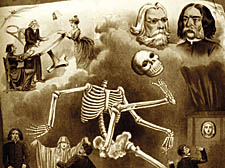|
|
 |
| |
The crime and grime of those good old days
Novelist Gilda ’O Neill looks at the teeming underbelly of Victorian London life, writes Peter Gruner
THE GOOD OLD DAYS by Gilda O’Neill
(Crime, murder and mayhem in Victorian London),Viking (Penguin), £16.99. order this book
AAAH…the good old days. Families stuck together and had singsongs around the piano. There were Victorian values, people worked hard, were thrifty – and everyone knew their place.
That’s the popular image, but as Gilda O’Neill points out in her fascinating book The Good Old Days, people have a tendency to glamorise the past in order to moan about the present.
Ms O’Neill takes the reader on a powerful exploration of the teeming fog-bound streets of London in the 19th century – and, in the words of the Ralph McTell song, she shows you something to make change your mind.
It wasn’t just the rat-infested slums, common lodging houses, boozers, penny gaffs, street crime and brothels that made life in the heart of the greatest empire in the world so unpleasant, it was also the terrible smells.
Our delicate noses, used to the deodorised world of 21st-century living, would never cope with the dung-slicked streets, the rank stench of overcrowded slaughterhouses and the perennial problem of disposing of “night soil”.
Waste had been dealt with in earlier periods simply by dumping it in open gullies, but by Victorian times a system had been introduced in which open cesspits were built under dwellings.
These basement holes were allowed to fill until they were overflowing with excrement, at which point, eventually, they were emptied and the daintily named “night soil” could be taken away – at a cost – to the east to fertilise the fields and market gardens of Essex.
In 1847, out of desperation, cesspits were banned, but as there was nothing to take their place it was only a matter of time before disaster struck. Rubbish was deposited in any available sewer and stream, which in turn decanted their filth into the Thames.
The record heat of 1858 became the year of the ‘Great Stink’ when even the Houses of Parliament were affected. So bad was the smell that drapes soaked in lime chloride were hung at the windows, and carbolic acid and chalk were thrown into the filthy river to make the air fit to breath.
The 19th-century, Ms O’Neill writes, was a time when not only were there massive gulfs being created between the upper, middling and working classes, but there was a growing awareness of the existence of an even more impoverished underclass – “a terrifying demi monde of criminals, tarts and no hope low lifes”.
In the poor East End many lived in multiple occupancy dwellings with no proper cooking facilities and depended on the street vendors and food shops for their meals. There were and still are eel and pie shops, such as one run by Ms O’Neill’s grandmother, in most East End markets.
She writes: “There were fried fish sellers who offered cold fish from trays hanging around their necks that were so popular with the Jewish community. It was from here that the popular fish and chip shops evolved.”
Street crime like mugging was prevalent and garrotting involving strangulation was a particularly nasty crime.
It only became an issue when MP Hugh Pilkington was attacked in 1862. It resulted in the re-introduction of flogging and some nervous types even wore specially tailored spiked collars to deter the midnight stranglers.
Today there is reality TV but in Victorian times there were penny gaffs – a sort of “reality performance” for the young. These were makeshift theatres set up in a shop or warehouse where blood-curdling melodramas, involving anything from throat-slitting robbers to brutal, wife beating husbands, would be acted out to the delight of a drunken audience. Musical interludes were presented by scantily clad – in Victorian terms – young women with dubious talents but fetching to look at.
The legal age for consent for girls was 12 up until 1875, when it was raised to 13. In order to avoid the miseries of the workhouse many women were forced to turn to prostitution and figures from the Lancet suggest that one house in 60 was a brothel in 1857.
One of Britain’s earliest filmmakers, Esme Collings, who lived in Brighton, made the world’s first-ever porn film called Women Undressing.
Gilda writes: “Pornography was still most graphic in the written form, encompassing everything from cheap booklets, to the massive collections put together by successful businessman and scholar Henry Ashbee.
On his death he donated his collection to the British Museum.
But the Victorians’ desire to keep sex in the closet meant blackmail was a big problem for those with unconventional tastes.
A simple scam was perpetrated by art dealer Charles Howell. He befriended well-known Victorians like Ruskin, Whistler, Millais, the Rossettis and Swinburne.
Howell would identify his victim’s potentially embarrassing sexual predilection, which he would feign to share. The poet Swinburne, for example, was said to enjoy visiting homosexual brothels that catered for his specific sado masochistic tastes.
Howell made sure that letters were exchanged between them, discussing his mark’s preferences. Then he would threaten to expose the letters unless the victim coughed up some decent cash.
Novelist Jack London was always worrying about the poor and how in the greatest empire the world has ever known people were forced to live off street garbage. In The People of the Abyss, written in 1902 he wrote. “From the slimy sidewalk, they were picking up bits of orange peel, apple skin, and grape stems, and they were eating them.”
 |
 |
| |
|
 |
|



